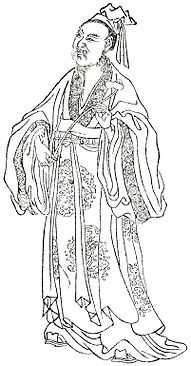Orchid Pavilion Gathering

The Orchid Pavilion Gathering (353 CE) was a cultural and poetic event during the Six Dynasties era, in China. This event itself has a certain inherent and poetic interest in regards to the development of landscape poetry and the philosophical ideas of Zhuangzi.[1] The gathering at the Orchid Pavilion is also famous for the excellent quality of the calligraphy of Wang Xizhi (303-361),[2] who was both one of the participants as well as the author and calligrapher of the Preface to the Poems Composed at the Orchid Pavilion, not to mention the literary quality of this introduction.
The Orchid Pavilion Gathering of 42 literati included Xie An and Sun Chuo (320?-380?[3]) and Wang Pin-Chih (fl. 400) at the Orchid Pavilion (Lanting) near Shaoxing, Zhejiang, during the Spring Purification Festival, on the third day of the third month, to compose poems and enjoy the wine. The gentlemen had engaged in a drinking contest: wine cups were floated down a small winding creek as the men sat along its banks; whenever a cup stopped, the man closest to the cup was required to empty it and write a poem. This activity was known as "floating goblets", or liu shang (流觴). In the end, twenty-six of the participants composed thirty-seven poems.
Modern influence
There is an Orchid Pavilion Calligraphy College in Shaoxing University. The musical artist Jay Chou has a song "蘭亭序" (Lán Tīng Xù Orchid Pavilion), by Vincent Fang. Many versions of reproductions of the calligraphic masterpiece Preface to the Poems Composed at the Orchid Pavilion yet exist.
Scroll copy of "Lantingji Xu"

Gallery
The events of the Orchid Pavilion Gathering and the ensuing poems have inspired not only generations of poets, but also painters and other artists.
-

Wang Xizhi(王羲之)was a Chinese calligrapher, traditionally referred to as the "Sage of Calligraphy" (書聖). This image was carried on the book which is called "Wan hsiao tang-Chu chuang -Hua chuan(晩笑堂竹荘畫傳) " which was published in 1921(民国十年).
-

Main text of an early Tang Dynasty copy of Wang Xizhi's Lantingji Xu by Feng Chengsu (馮承素), located in the Palace Museum, Beijing. This is considered the best surviving copy.[1] Many copies in Chinese history were made from a lost original possibly buried in Emperor Taizong's mausoleum.
-

Juran - Xiao Getting the Orchid Pavilion Scroll by Deception.
-

Xiao Yi Trying to Swipe the Lanting Scroll, Song (960–1279) copy of a Tang original painting.
Cite error: There are <ref> tags on this page, but the references will not show without a {{reflist}} template (see the help page).
See also
- Admonitions Scroll
- History of graphic design
- Juran (painter)
- Lantingji Xu
- Orchidaceae
- Shangsi Festival
- Six Dynasties poetry
- Xie An
- Zhejiang
Notes
- ↑ Chang, 6
- ↑ Wang Xizhi. Encyclopædia Britannica
- ↑ Yip, 137
- ↑ Alsop, Joseph (1982). The rare art traditions: the history of art collecting and its linked phenomena wherever these have appeared: Volume 27 of A.W. Mellon lectures in the fine arts. Harper & Row. p. 231. ISBN 0-06-010091-5.
References
- Chang, H. C. (1977). Chinese Literature 2: Nature Poetry. (New York: Columbia University Press). ISBN 0-231-04288-4
- Yip, Wai-lim (1997). Chinese Poetry: An Anthology of Major Modes and Genres . (Durham and London: Duke University Press). ISBN 0-8223-1946-2